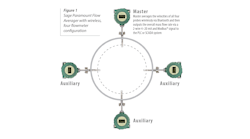Multipoint Thermal vs. DP Flowmeters for Combustion Air Flow Applications
Coal-based power plants throughout the world are responsible for generating from 41 percent to 93 percent of the power for developed and developing countries. Many of these coal-fired power plants have been around for decades, but even some of the newly designed plants rely on older technologies for combustion air flow measurement. Primary air, secondary air, and over-fire air flow measurements are commonly used in coal plants to properly control the coal and air mixture at the burners and meet environmental regulations.
Differential-pressure (DP) devices (such as Pitot tubes) and flow restrictors (such as airfoils and Venturis) are commonly used because the measurement principle has been around as long as coal. However, the challenges facing coal-fired power plants (such large ducts; limited metering runs; poor velocity and temperature profiles; vibration; and high temperatures) make using DP primary elements and flow restrictors a less-than-ideal choice when trying to achieve low operating cost, low maintenance, high accuracy, and high repeatability.
Flow Measurement with a Pitot Tube
Pitot tubes provide an actual velocity measurement, not a mass flow (PPH) measurement, which is needed to properly control the air-to-fuel ratio. To obtain the data needed to control the combustion process and minimize pollutants, fuel loss, and shutdowns, the process needs a temperature and pressure measurement that is used with the volumetric flow to calculate the mass of air/oxygen molecules being delivered to the process coal burners.
Pitot tubes are also better suited for particulate-free air flow. Coal plant combustion air contains fly ash particulates that require a purge system to ensure the primary element stays reasonably close to the original factory performance. Any particulates are prone to plug the Pitot tube and impulse lines, and will affect the accuracy of flowrate readings. Purge systems can also be a secondary source for maintenance nightmares with regard to maintaining clean, dry purge air and tube leaks.
Additionally, the minimal turndown ratio of Pitot tubes makes them incapable of reading the low flows that occur during startup, shutdown, or obstruction events.
READ ALSO: WHITE PAPER—Combustion Efficiency and Thermal Mass Flow Meters
Flow Restrictors & Pressure Drop
Flow restrictors in the flow stream prior to the combustion chamber create a pressure drop that subsequently produces lower output from the boiler. This pressure drop is a direct result of the restricted flow. To adjust for this pressure drop, facilities frequently oversize or overwork the air blowers, compressors, or fans to increase upstream flow or use heaters to preheat the upstream air. However, these methods for increasing the flow and flow temperature also lead to increased costs for fuel, equipment, and maintenance.
Reduce Maintenance & Improve Performance
The goal of any power plant modifications (whether voluntary or required) is to implement a change that improves efficiency, reduces maintenance, reduces operating costs, supports rapid installation, or enhances reporting capabilities for a cost that pays for itself through reduced fuel usage or accurate emissions records.
An advantage to removing the pressure drop caused by flow restrictors is that low NOx burners are able to operate more efficiently and demonstrate better performance at reducing NOx levels. The low-NOx concept includes staged air combustion, staged fuel combustion, and external flue gas recirculation (FGR), which are all based on the principle of breaking down the combustion in an attempt to reduce prolonged high temperatures. “Staged combustion” or “NOx ports (over fire air)” uses multiple sections, where each section uses a stepped-up heat to reduce the time high temperatures are within the critical NOx range. The abundance of oxygen carried by the excess air created by overworked or oversized blowers increases the temperature, which increases NOx formation.
Multipoint thermal mass flowmeters are a good solution for a low-cost, low-maintenance, and highly accurate alternative for DP devices and flow restrictors. By replacing these traditional DP elements, it becomes much easier and more cost-effective to design and maintain your combustion control system—saving potentially hundreds of thousands of dollars per year in maintenance costs. Removing the pressure loss created by flow restrictors, additional savings can be realized by reducing the amount of power needed to generate the same mass air flow.
Thermal mass insertion flow measurement systems can be used to replace a DP system and use the same piping or duct configuration common throughout the rest of your combustion control system.
Thermal mass flowmeters have almost zero effect on the flow stream, proven high accuracy, and are more economical for both initial and maintenance costs. Industrial thermal mass meters have a high degree of velocity sensitivity, support solid turndown ratios, and respond quickly to velocity and temperature changes. Additionally, some thermal mass flowmeters automatically provide the mass flowrate so no additional equipment or conversion is required to achieve repeatable and reliable air measurements, helping to achieve efficiency throughout the facility.
The need for accurate, repeatable, and reliable combustion air measurements in power generation plants is critical for efficient operation and safety throughout the entire facility and processes. Accurate primary air flow measurement is required to properly dry and convey the coal particles to the burner. Accurate secondary air flow measurement to the burners is critical for maintaining the proper air-to-fuel ratio that results in more complete and stable combustion, creates better heat rates, helps avoid mill puffs, and supports lower emissions.
Bruce Burton is the Director of Engineering at Kurz Instruments with over 23 years of experience in researching, designing, and developing thermal devices for mass flow measurement in dry gas, condensing gas, and steam applications.
Robert Morpeth is a Senior Staff Writer at Kurz Instruments with over 25 years of experience in researching and documenting processes and procedures.



